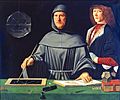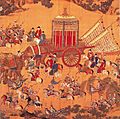15th century facts for kids
| Millennium: | 2nd millennium |
|---|---|
| Centuries: | 14th century · 15th century · 16th century |
| Decades: | 1400s 1410s 1420s 1430s 1440s 1450s 1460s 1470s 1480s 1490s |
| Categories: | Births – Deaths Establishments – Disestablishments |
The 15th century was a really exciting time in history! It lasted from the year 1401 to 1500. During these 100 years, many amazing things happened that changed the world forever. People explored new lands, invented new tools, and created beautiful art. It was a time of big changes and new ideas!
Contents
A World of Exploration
The 15th century was famous for its brave explorers. They sailed across huge oceans to find new trade routes and lands.
Christopher Columbus's Journey
One of the most famous explorers was Christopher Columbus. In 1492, he sailed west from Europe, hoping to reach Asia. Instead, he landed in the Americas! This journey was a huge moment. It connected Europe with the Americas for the first time. It also started a new age of exploration.
Other Explorers
- Vasco da Gama was a Portuguese explorer. He was the first European to sail around Africa to reach India in 1498. This opened up a new sea route for trade.
- Explorers like John Cabot also made important voyages. They helped map out more of the world. These trips changed how people saw the world. They also led to new trade and cultural exchanges.
Big Inventions and Ideas
This century also saw some very important inventions. These changed how people shared information and learned.
The Printing Press
One of the most important inventions was the printing press. It was invented by Johannes Gutenberg around 1440. Before this, books were copied by hand, which took a very long time. The printing press made it much faster and cheaper to print books.
- More people could read books.
- Ideas and knowledge spread quickly.
- This invention helped start the Renaissance. This was a time of great art and learning.
New Ways of Thinking
The 15th century was also part of the Renaissance. This was a period when people became very interested in art, science, and learning.
- Artists like Masaccio created amazing paintings.
- Architects like Filippo Brunelleschi designed incredible buildings.
- People started to question old ideas. They looked for new ways to understand the world.
Important Events and Conflicts
Many important events shaped the world during this century.
The Fall of Constantinople
In 1453, a huge event happened. The Ottoman Empire captured the city of Constantinople. This city was the capital of the Byzantine Empire. Its fall marked the end of the Middle Ages for many historians. The Ottomans, led by Mehmed II, became a very powerful empire.
The Hundred Years' War Ends
The Hundred Years' War between England and France finally ended in 1453. This long war had lasted for over 100 years. A young French peasant girl named Joan of Arc played a big part in helping France win. She became a national hero.
The Wars of the Roses
In England, there was a series of civil wars called the Wars of the Roses. These wars were fought between two powerful families: the House of York and the House of Lancaster. They were fighting for control of the English throne. The wars ended when Henry VII became king in 1485. He started the Tudor dynasty.
Famous People of the 15th Century
Many important people lived during this time. They made a lasting impact on history.
- Skanderbeg (1405–1468): He was an Albanian hero. He led a strong resistance against the Ottoman Empire.
- Ivan III of Russia (1440–1505): Known as Ivan the Great, he was a Grand Prince of Moscow. He helped Russia become a powerful state. He ended the rule of the Tatars in Russia.
- Luca Pacioli (1445–1517): He was an Italian mathematician. He is often called the "Father of Accounting." He wrote a book that explained how to keep financial records.
Images for kids
-
Ottoman Sultan Mehmed II, victorious at the Ottoman conquest of Constantinople and the fall of the Byzantine Empire. Various historians describe it as the end of the Middle Ages.
-
Joan of Arc, a French peasant girl, directly influenced the result of the Hundred Years' War.
-
Detail of The Emperor's Approach showing the Xuande Emperor's royal carriage. Ming Dynasty of China.
-
Modern painting of Mehmed II marching on Constantinople in 1453
-
The Siege of Rhodes (1480). Ships of the Hospitaliers in the forefront, and Turkish camp in the background.
-
Gergio Deluci, Christopher Columbus arrives in America in 1492, 1893 painting.
-
Filippo Brunelleschi (1377–1446), regarded as one of the greatest engineers and architects of all time
-
Johannes Gutenberg (1400–1468), German inventor who introduced printing to Europe with his mechanical movable-type printing press
-
Skanderbeg (1405–1468), who led the Albanian resistance against the Ottoman Empire
-
Ivan III of Russia (1440–1505), Grand Prince of Moscow who ended the dominance of the Tatars in the lands of the Rus
-
Richard III of England (1452–1485), the last king of the House of York and the last of the Plantagenet dynasty
-
King Henry VII (1457–1509), the founder of the royal house of Tudor
See also
 In Spanish: Siglo XV para niños
In Spanish: Siglo XV para niños














